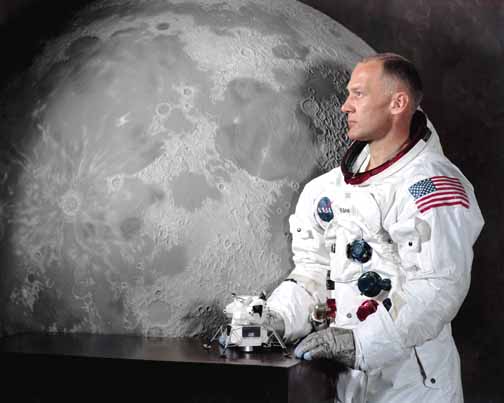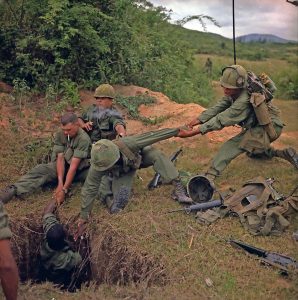July 20, 1969—a day that would go down in history, as the first humans went on to set foot on the Moon. With an estimated 530 million people worldwide watching at the time, today’s generation can recall their parents or grandparents describe the chills they felt as Neil Armstrong spoke his famous words.1 People today tend to forget that there was a second man to touch down some fifteen minutes after Armstrong: Edwin “Buzz” Aldrin, a man sometimes forgotten simply because he was not the first man on the Moon, on a mission that could have been quite capably another NASA tragedy.
The Apollo 11 Mission consisted of a crew of three men; Apollo 11 Commander Neil Armstrong, Command Module Pilot Michael Collins, and Lunar Module Pilot Edwin “Buzz” Armstrong.2 On July 16, 1969, the crew prepared to launch from Cape Kennedy in Florida. Aldrin described what he saw, as his colleagues were being strapped into the rocket. He took in the moment and the magnitude of the journey the crew was about to embark on:

“As far as I could see there were people and cars lining the beaches and highways. The surf was just beginning to rise out of an azure-blue ocean. I could see the massiveness of the Saturn V rocket below and the magnificent precision of Apollo above. I savored the wait and marked the minutes in my mind as something I would always want to remember.”3
At 9:32 a.m. on July 16, 1969, the Saturn V Rocket ignited, launching the crew of Apollo 11 towards the Moon some 238,900 miles away. Aldrin poetically describes his view of Earth from space, “The thought reoccurred that wars are generally fought for territory or are disputes over borders; from space the arbitrary borders established on Earth cannot be seen.”4
On July 20, with the ever growing Moon in sight, the Lunar Module detached from the Command Module. From here on out, Aldrin was the pilot. It was his turn to etch his name in the history of humankind.
While advancing toward the Moon’s surface, the dreaded yellow caution light came on. Being so far away from Earth, yet so close to the surface of the Moon, the astronauts’ only hope was that the malfunction wasn’t critical. “Hearts shot up into throats while we waited to learn what would happen.”5 The crew received another caution warning before being told by their flight commander back in Houston to proceed. Following the first two warnings, Aldrin and Armstrong went on to receive at least three more warnings before being reassured, once again, that the mission was still a go.
July 20, 1969 at 4:17 p.m. — Edwin “Buzz” Aldrin successfully lands Lunar Module Eagle on the surface of the Moon in Mare Tranquillitatis (The Sea of Tranquility). Command Center has been painfully waiting four long days to hear Aldrin radio the words of success: “Houston, Tranquility Base here. The Eagle has landed.”6

Edwin “Buzz” Aldrin became the second man to set a pair of footprints on the surface of the Moon some fifteen minutes after his Command Leader Neil Armstrong initially touched down. When asked about the Moon’s scenery, Aldrin described it as “Beautiful, beautiful. Magnificent Desolation.”7 The crew spent the following hours taking samples from the Moon, taking photos, and of course, planting the American Flag on the Moon’s surface.
Twenty-one hours after landing, it was time to head back to Earth. The Eagle would meet back up with the Command Module Columbia and its pilot Michael Collins in the Moon’s orbit. The crew shared a brief celebratory moment before preparing their return voyage—back towards Earth’s orbit. The crew would return to Earth eight days after launch, landing in the Pacific Ocean on July 24, 1969.8 In a stunning display of American science Buzz Armstrong, along with the rest of the Apollo 11 crew, ultimately ended the Space Race—heeding President John F Kennedy’s 1961 call to put American men on the Moon and safely return them before the decade’s end.

“And, therefore, as we set sail we ask God’s blessing on the most hazardous and dangerous and greatest adventure on which man has ever embarked.” — John F. Kennedy, September 12, 1962
- Sarah Loff, “Apollo 11 Mission Overview,” NASA, April 17, 2015. http://www.nasa.gov/mission_pages/apollo/missions/apollo11.html. ↵
- Lawrence W. Baker, Sarah Hermsen, Rob Nagel, Peggi Saari, Space Exploration Reference Library (Detriot; UXL, 2008), 178. ↵
- Edgar M. Cortright, Apollo Expeditions to the Moon: The NASA History (Courier Corporation, 2012), 204. ↵
- Edgar M. Cortright, Apollo Expeditions to the Moon: The NASA History (Courier Corporation, 2012), 206. ↵
- Edgar M. Cortright, Apollo Expeditions to the Moon: The NASA History (Courier Corporation, 2012), 212. ↵
- NASA Content Administrator, “July 20, 1969: One Giant Leap For Mankind.” NASA, February 19, 2015, http://www.nasa.gov/mission_pages/apollo/apollo11.html. ↵
- Buzz Aldrin and Wayne Warga, Return to Earth (Open Road Media, 2015), ebook. ↵
- Buzz Aldrin and Wayne Warga, Return to Earth (Open Road Media, 2015), ebook. ↵



97 comments
Robert Freise
The discovery of space has been so fascinating to me. The idea of limitless discovery and the possibility of seeing earth while in space would be a dream. Buzz Aldrin story has always been so captivating to me. The pictures used to show how important the stage of being in control of a space shuttle is pretty cool. This article was a very great read and Congrats on the nomination.
Daniel Linstead
This was a good article, interesting read and was able to learn a lot about Apollo 11. One thing that I have always struggled to wrap my head around is the fact that even though there was two other men along with Buzz Aldarin, just because they were a major key “second step for man kind” they aren’t as famous as Buzz Aldarin even though it was the same mission.
Jose Sanchez
This article although rather short, was very well written and interesting. While Armstrong gets all the credit, it took a team to get them there and all of them were just as crucial to the mission as the others. The moon landing will forever be a great achievement for the United States and mankind and we should remember all who were there and made it possible.
Pedro Gonzalez Aboyte
I really like this article because it talks about the Apollo 11 mission in a way that we are not accustomed to. The central man is Buzz Aldrin and not Neil Armstrong. Buzz Aldrin was a crucial man in the Apollo mission and deserves just as much credit as Armstrong. There is something about when Aldrin describes the Earth that is poetic and I feel like that is the kind of man he is. All of the men involved in the mission deserve equal and great amounts of respect for what they accomplished.
Matthew Wyatt
Buzz Aldrin’s contribution to the Apollo 11 cannot be understated. He deserves just as much credit as any other crewmember for his heroism. There are a few edits that still need to be made in order for this article to really shine. For example, in the last sentence of the first paragraph the word “capably” should instead be “possibly.” “Capably” refers to doing something with skill and competence, not really an appropriate word for describing a potential failure.
Avery Looney
Everyone has heard of Neil Armstrong, but a lot of people have never heard of Edwin “Buzz” Aldrin. The Apollo 11 mission is one of the biggest accomplishments for the United States and it is crazy to see how far our technology has come. This article is very well written and is a great read! I love how it told the story about Buzz Aldrin rather than Neil Armstrong. The title for this article is very creative and it deserved the nomination it received for best title!
Megan Copeland
This article was so interesting to read. I still can’t believe that Buzz Aldrin walked on the moon. That seems so crazy to me. I can’t even imagine what he must have been thinking when he became the first man to ever walk on the moon. This put an end to the space race against the Soviet Union, because they finally put someone on the moon. I love the title of this article. I think it made the article seem very interesting before even reading it.
Richard Morales
Very interesting article about a man who is often overlooked in our history. Whenever we speak about the outstanding mission of Apollo 11 we most often times associate the event solely with Neil Armstrong, but is important we remember the stories of the other astronauts as well including Buzz Aldarin. I enjoyed learning more about Aldarin, the second man to step foot on the moon, and how he described the “Beautiful, beautiful. Magnificent Desolation.” Great read and congratulations on your nomination.
Luke Lopez
This was a very interesting article on Buzz Aldrin, and how he was the second man to step foot on the Moon. It must have been very scary for everyone on board to see the yellow caution light come on as they were on their way to the Moon. Overall this was a very well-written article that detailed how Buzz Aldrin and the rest of the Apollo 11 crew ended the Space Race.
Crystal Baeza
I enjoyed reading how this article showed a different view of Apollo 11 from someone other than Armstrong. I find it interesting how the other two astronauts weren’t as big of a deal simply because they technically weren’t the “first man on the Moon”. I feel as if they should all be equally praised for their success. This was a great read and well-written. Congratulations on your nominee!